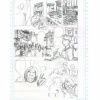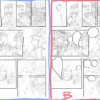Drawing Manga Pages
Description
Are you new to manga drawing and perhaps not sure how to go about it? Great, because in this tutorial you'll find out about a lot of the essential aspects of creating a manga page!


The purpose of this tutorial is to show you the process behind drawing (more or less) professional manga/comic pages! I will use the first page of my short story (Karma) for...

First of all, since a manga page is supposed to be printed and trimmed afterwards, we have to be careful of our layout. For printing, a page is separated into three areas: ...

If you want to make this step easier for yourself, you may want to use special comic book paper. Nowadays it‘s quite easy to find via the internet and it‘s fairly...

Now, let‘s start drawing our page! First, we need to find out what the content of the page should actually be and how it's supposed to be arranged in the layout. For...

Okay, now that we have a good idea of how our page should look like, it‘s NOT time to draw it yet XD ! First it‘s time for research! This step is often...

Using our previous sketches as guides and the reference photos as inspiration for our designs it's finally time to draw the pencil draft! Usually the first page of a...

The pencil draft doesn‘t have to be a piece of art, but the more effort you put into it, the easier the inking process will become. Guidelines and vanishing points are...

After we've introduced the scenery, it's time to get to the characters! These panels‘ job is to present characters to the reader, usually in a portrait-like way. This...

The last two panels show a conversation between these two characters. In manga time flow and reading direction are intertwined. Therefore it‘s important to arrange the...


My usual inking procedure goes like this: I begin by outlining the panel borders with a fineliner and make sure to leave spaces for speech bubbles that go outside the panels...

After the speech bubbles have dried, the contents of the panels are ready to be inked. Hint: If you want to safe your inks from smudges, it‘s advisable to work...

Well inked lineart doesn't only have to look nice, but also aid in making your scenes easier to understand. Traditional black and white manga rely on clear lineart much...

The important thing about contrasts is to maintain the right balance. There are essentially 3 methods to create contrasts: 1) cross-hatching/fine details 2) half tones 3)...

The idea for this two panels was to convey atmosphere, so I decided to draw these stills with clean, thin lines in order to make the details and designs distinguishable. As...

The establishing shot of the market place is a bit of a laborious piece to ink... but a good mangaka shan't be lazy XD What we have to be careful about is adjusting the line...

For the character introduction panel I chose to work with contrast in order to help him stand out from the background. I shaded the background with simple cross-hatching...

The last panels are fairly lazy, as well XD . Rather than drawing the backgrounds every time, it's sometimes more effective to use speed lines or other atmospheric effects...

Once the page has been inked, it's best to leave it to dry for a while before scanning it. After the page is scanned, we can use a software such as Photoshop or MangaStudio...

The best way to simulate the look of the sky in a manga is usually by using a gradient screen tone, so that's what I did. Here‘s my approach: I create a new layer above my...

The rest of the page is basically toned in the same way. However, when applying two screen tone layers over another, make sure to avoid moirés. You can usually achieve that...

The last step of the creation of a manga page is lettering. Depending on what kind of manga or comic you make, it‘s not necessary to have a ‘typical‘ comic font consisting...

And this is the finished page in all it‘s glory! The bleed area will be cut off and the rest will be printed. Maybe... XD I hope you‘ll be able to use these tips to...
